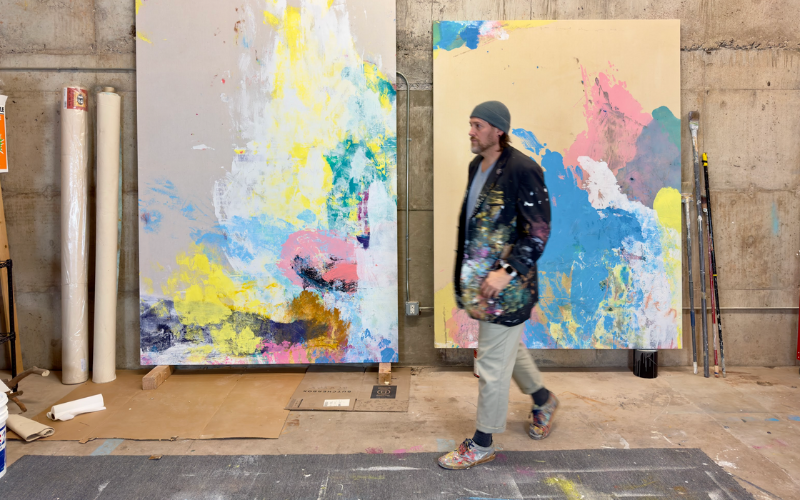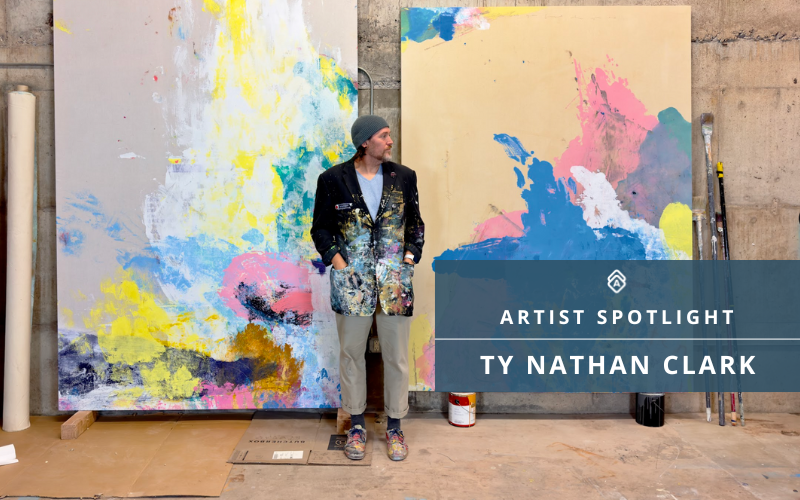Ty Nathan Clark has never limited himself to a single medium—or a single message.
From large-scale paintings and mixed media works to sculpture, filmmaking, podcasting, and mentorship, Clark’s career spans decades of exploration and impact.
Raised in a family of artists and mentored by sculptors and painters alike, this week's Featured Artist fuels his work by memory—personal and collective. Each series begins with writing, journaling, and reflection. His creative process is layered and sensory, with music often serving as an emotional through-line for each body of work.
Using unconventional materials like cement, ash, thread, yarn, and found objects, Clark’s art investigates the complexity of healing, the messiness of trauma, and the ever-changing shape of faith and identity. His process is deeply physical, involving dancing, jumping, pressing his weight into surfaces—bringing body and soul into every piece.
His focus is on creating a body of work that develops and matures over a lifetime—one that evokes emotion by accessing both what we remember and what we’ve forgotten.
Artwork Archive had the chance to chat with Ty Nathan Clark about his creative process, the physical movement behind his work, and how Artwork Archive has become his go-to tool.
You can see more of his work on Discovery and learn more about his art practice below:
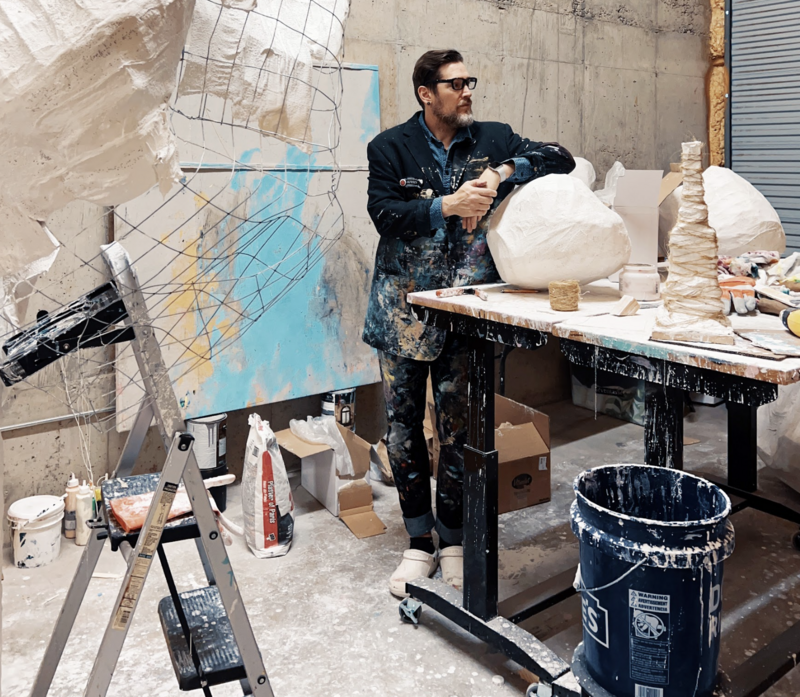
Ty Nathan Clark surrounded by sculpture materials in his studio. Photo courtesy of the artist
Where the work really begins
For Ty Nathan Clark, the earliest stages of his creative process unfold slowly and thoughtfuly—and often far from the studio. "I'm constantly writing, journaling, and note-taking," the artist explains—collecting fragments of stories, poems, and memories that eventually form the emotional spine of a series.
When a concept starts to solidify, he gives it time to evolve. That's when music enters the picture. “Once I feel strongly about my notes, I create a playlist of music that goes with the idea, prose, or memory,” he muses. Music doesn’t just play in the background—it scores the entire creative rhythm. His Spotify now holds over 500 playlists, many tied to specific projects.
Piece titles come next. He'll draft dozens of them—"20 or 30 at times"—pulled from poems, fleeting thoughts, or significant moments. “They are always adapting and changing throughout the work,” Clark says.
When it's finally time to pick up the materials, he lets his emotions lead. “I cut the canvas in random scales and begin. I never pre-sketch or think through composition—I just begin with the emotion and characteristics of what I’ve been ideating about for that body of work and let the divine spark guide me.”
Letting the body lead the process
Movement has always played a role in this artist's creative rhythm—though it’s become more intentional over time. What started as a natural way of shifting between the floor and wall evolved into something much more embodied.
“Once I started experimenting with using cardboard for transfer within my work, things took another physical step,” Clark remembers. “To press paint from cardboard to canvas, I used my body weight, and I had to figure out how the application of that weight changed the resulting relief.” As he worked, he began to notice how even small shifts in pressure created new visual textures. That awareness made him more attuned to how different movements could shape a piece.
Much like the early stages of his creative process, music plays a major role here too. “I occasionally find myself dancing, overtaken by the music’s rhythm,” he says. “My studio is my cathedral and my playground.” This balance between spiritual focus and playful energy keeps Ty Nathan Clark's process open. “My intention is for spiritual devotion and playful joy to remain ever-present. These emotions help keep that childlike wonder alive within the work.”
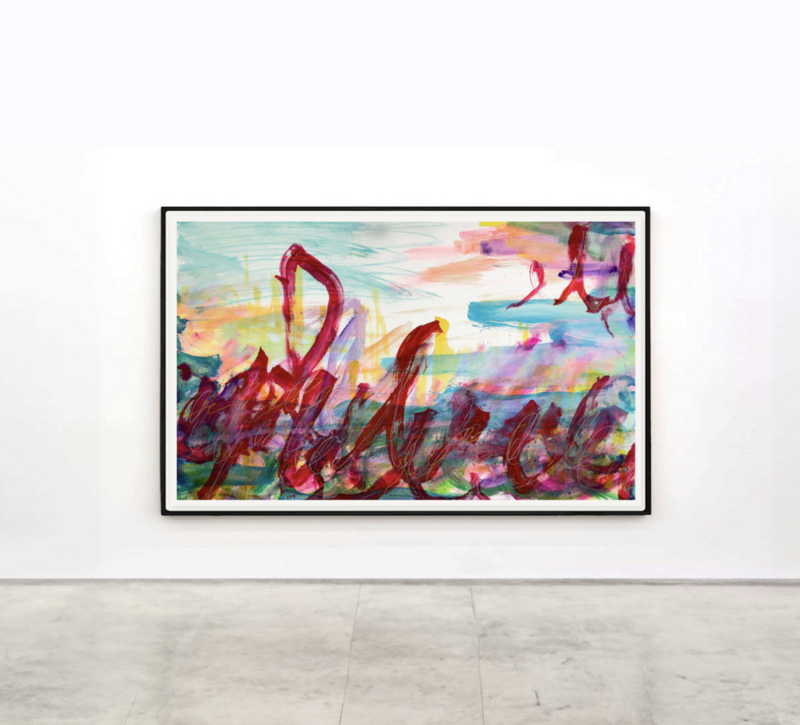 Ty Nathan Clark, There is a Rhythm in You that Makes Me Want to Dance. (Based on the song Give What you Take by Mojave 3), 55 x 90 in 2024
Ty Nathan Clark, There is a Rhythm in You that Makes Me Want to Dance. (Based on the song Give What you Take by Mojave 3), 55 x 90 in 2024
Following the work across mediums
Ty Nathan Clark works across multiple disciplines—but doesn’t see them as separate. Each medium offers its own kind of language, and he follows whichever one speaks loudest in the moment.
“Painting is #1, the foundation for me,” he reveals. Still, other creative forms have always been part of the mix. “Despite my initial focus on sculpture and ceramics, I’ve always written as well—a tradition passed down from my grandfather, a writer himself.”
Each mediums has its place, and Clark keeps jounrals labeled accordingly: For Painting, Writing, Video/Film. They’re ready for whatever form a new idea might take. “Whatever jumps in my process of writing out my ideas, I run with.”
His relationship with mediums is fluid, grounded more in instinct than in discipline-specific boundaries. Wherever the idea feels most urgent to express—that’s where he goes.
A slower pace, a deeper purpose
Ask Ty Nathan Clark about artistic growth and you’ll get a quiet truth that’s as humbling as it is real: “This is big. Understanding that art takes time. A time unlike any we've known. It is a slow, long road.”
That realization shifted the way he thought about success, sustainability, and what it means to build a life around art. “I studied, then studied more, and studied even more.” Through that process, he began to see patterns—not just in his own work, but in the careers of artists he admired. “Seeing that my artistic heroes had similar experiences was a major confidence builder.”
There may not be much glamour in taking things slowly—but for Clark, there’s a kind of peace in it. And over time, a certain kind of confidence too. “If you understand this, and become comfortable with patience, you can outlast others and probably find your place in the art world.”
The artist who came before
Before Ty Nathan Clark ever knew what it meant to live as a working artist, he had an early example in his family: his great uncle, affectionately known as “Uncle Jiggs.”
Jiggs was a potter and printmaker, known for his long grey beard and clay-crusted trousers. “He died when I was 10, preventing me from knowing him,” Clark says. “But I fondly remember him—his artistic comportment, the way his work filled our family homes.”
That influence never left—and now, as this artist continues on his own creative path, Jiggs' legacy is still close at hand. Three of Jiggs’ pieces—a lithograph and two raku pots—still live in Clark's home. “I always wanted to be him—an artist," he proclaims. "I know it’s in my DNA. I always feel like he is watching me in my studio.”
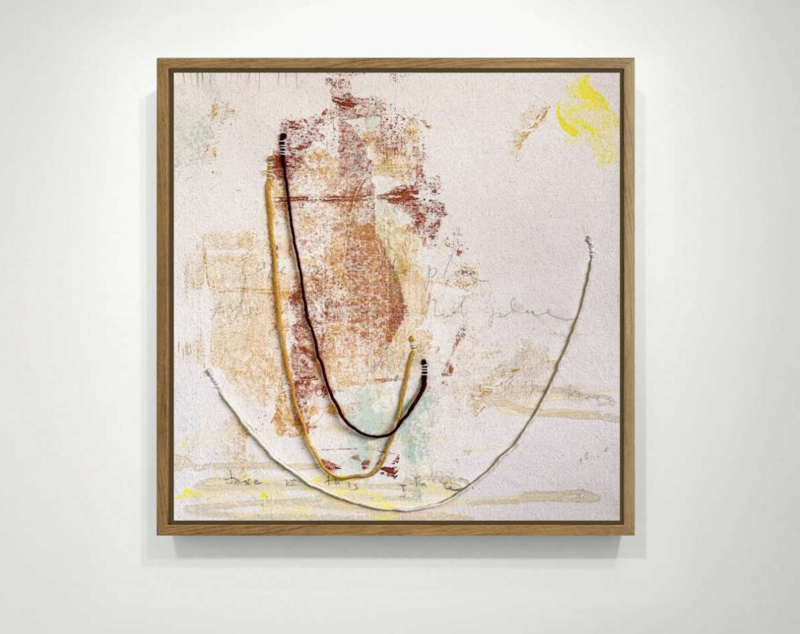
Ty Nathan Clark, 'Study in Connecting Moments from a String. Pt.3' 19 x 19 in, 2025
From spreadsheets to systems
This artist has always been a meticulous record-keeper—one who used to document all his inventory and gallery consignments in spreadsheets. But as his practice grew, so did the complexity—and the files became unmanageable.
"My spreadsheets ballooned to multiple gigabytes, quickly becoming overwhelming,” Clark recalls. “Artwork Archive had been on my radar for years, and I finally switched.”
The new setup offered exactly what he needed—especially as the demands of his practice evolved. Now, Ty Nathan Clark uses Artwork Archive to keep his art business organized, track consigned pieces, and generate reports with ease. "[Artwork Archive's] UI excels at detailed artwork cataloging, particularly for consigned pieces from my galleries and dealers,” he shares.
One of his favorite features has been the reporting tools—especially when it comes to insurance. “Renewing my art insurance policy and generating an Inventory Report to determine the total value of my artwork was surprisingly easy.”
Instead of wrestling with files, he spends more time in the studio—and trusts that the business side of his practice is covered.
Group your work by series—it tells the full story:
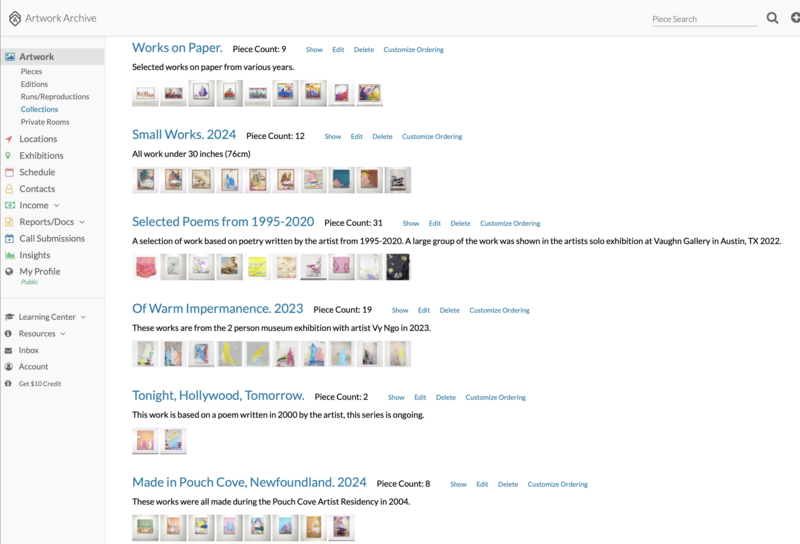
In Ty Nathan Clark’s account, you’ll see collections like “Of Warm Impermanence” and “Small Works, 2024.”
Organizing your artwork into collections gives clarity to your portfolio. It also shows progression, themes, and context to galleries, collectors, and yourself.
Want your body of work to feel more intentional? Use the Collections feature in Artwork Archive to shape the narrative
Getting started, according to Ty Nathan Clark
When Ty Nathan Clark is asked what advice he’d give to emerging artists, he keeps it simple—and honest.
“For new artists, the focus should be on the art itself, first and foremost,” he says. That means putting energy into what happens in the studio—trying new things, making mistakes, and learning from them. “Devote your time to working, experimenting, risk-taking, and patience. Take your time. Everything else will come later. Do the work,” he adds.
When it comes to being an artist, it's never about perfection or speed—it’s about showing up (for your work and for yourself). Again and again.
